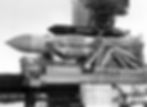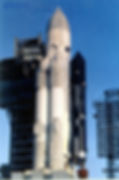The Empire Strikes Back: The "Barbarian" Satellite Polyus
- Aeryn Avilla
- May 25, 2024
- 7 min read
On July 17, 1975, high above the Earth, an American Apollo spacecraft docked with a Soviet Soyuz capsule and concluded the Space Race. For two days, the crewmen shared meals, performed joint science experiments, and held press conferences in an environment of cooperation that was unfathomable when the Space Race began almost two decades prior. The highly successful Apollo-Soyuz Test Project looked like the start of a long and beneficial partnership in space between the two superpowers.
That is, if the two countries didn't destroy each other first.

Polyus, the long, black spacecraft, mounted to the fuel tank of the Energia launch vehicle (buranarchive.space)
In 1972, the United States and Soviet Union signed the Anti-Ballistic Missile (ABM) Treaty, which prohibited the deployment of anti-missile weapons, though not their testing or development [0]. By the time of Apollo-Soyuz, ABM research in the U.S. was minimal, and mutually assured destruction (MAD) was still the main deterrence strategy, as it had been since the Kennedy administration. Then Ronald Reagan defeated incumbent president Jimmy Carter in the 1980 presidential election and felt some changes needed to be made.

In 1983, President Reagan announced the Strategic Defense Initiative, popularly known as "Star Wars" (thanks to Senator Ted Kennedy), to the American public in a national television broadcast. The Strategic Defense Initiative (SDI) was a space-based anti-ballistic missile program designed to render nuclear weapons obsolete by creating a "defensive shield" using directed energy, or lasers. The new program and Reagan's tough anti-Soviet policy were a strong divergence from the period of détente that preceded his presidency, and caught the West and even some of Reagan's administration off-guard. But not the Soviet Union, which had been researching anti-ballistic missile technology since the 1970s. NPO Energia, Sergei Korolev's former design bureau, was working on two anti-satellite (ASAT) concepts, Kaskad and Skif. The bureau used the SDI announcement to convince the Politburo to increase funding for the projects, which it argued could be used to target this new American threat. There were numerous proposed ASAT weapons aimed at annihilating SDI satellites, but this post looks at only Skif and the Energia booster.
Kaskad, Russian for "cascade", was a weapons platform that would have attacked satellites in geostationary orbits using missiles. Skif was a platform that would have annihilated satellites in LEO using lasers. The name was a reference to the Scythians, an ancient nomadic warrior tribe who occupied Central Asia and southern Russia, and an antiquated European term for "barbarian". Development of Skif was prioritized over Kaskad.

Skif (top) and Kaskad (bottom) — 1 is the spacecraft bus, 2 is the space-to-space missile system, and 3 is the laser complex (buran.ru)
Two lasers were developed for the Skif system. The first, called Dreif, was a 1-megawatt carbon dioxide laser created by NPO Astrofizika [1]. The other was developed by the Central Design Bureau of Chemical Automatics (KBKhA), but only Dreif would be chosen to fly on the Skif demonstration spacecraft, Skif-D. Around the time the Skif-D was approved (roughly summer 1984), the U.S. shifted its focus from large laser-equipped satellites to much smaller kinetic kill vehicles, against which the Skif would be less effective. This would make justifying the development of Skif more difficult in the coming years.
Skif-D was 131 feet long (40 meters), more than 13 feet in diameter (4 meters), and weighed more than 210,000 pounds (95 metric tons). It was made of two components— the functional block, which was the Russian term for spacecraft bus, and the payload module. The functional block was the main section of the TKS spacecraft, which was intended for uncrewed resupply flights to the Almaz space station, and housed the thermal control, radiocommunication, and telemetric control systems. The payload module contained two 1.2-megawatt turbogenerators and carbon dioxide tanks for the laser.
Another spacecraft, Skif-Stilet (Scythian-Stiletto), was being developed at the same time. However, while Skif intended to destroy American satellites, Skif-Stilet was to be equipped with a less powerful laser to merely blind them.

Artist's depiction of Skif in orbit. The functional block is on the left while the payload module is on the right (thespacereview.com)
Even though the Buran shuttle was slated to launch on the first Energia rocket (more on those later), development of the spacecraft fell behind and Skif-D was bumped ahead, though it would not be ready either. A dummy payload launch was scheduled for Fall 1986 but was not approved. A new test vehicle called Skif-DM (for "demonstration modification") had gas ejection vents and a targeting system as well as the 1-megawatt laser. Mission planners realized that venting large quantities of carbon dioxide from a spacecraft would alert American intelligence agencies to the development of a laser. Instead of expelling CO2, a combination of xenon and krypton would be vented to interact with Earth's ionospheric plasma and appear as a civilian geophysics experiment. Additionally, Skif-DM would deploy small balloon targets to track with its targeting system the way it would track enemy satellites in the future.

Polyus and Energia on the launch pad (buranarchive.space)
By 1986, Mikhail Gorbachev's rise to power and desire to change the trajectory of his country's military mirrored Ronald Reagan's— but in the opposite direction. In addition to advocating for perestroika, or economic and bureaucratic reforms, he was opposed to expensive military space spending. The Politburo put restrictions on what Skif-DM could do during its test flight: While orbiting the Earth was permitted, it was not allowed to deploy tracking targets or vent gas, even under the guise of a civilian experiment. It was important to prevent Skif from being seen as a weapon by the West in order to keep military spending minimal.

NPO Energia was also developing a shuttle, Buran, and a large super heavy-lift launch vehicle to hoist it into space, creatively named Energia. Skif was originally supposed to launch on a Proton rocket but was too heavy, so the Energia was chosen instead. Development on the launch vehicle began in 1976 alongside Buran after the N1 moon rocket program was cancelled. Energia had a height of 192.80 feet (58.76 meters) and a diameter of almost 58 feet (17.65 meters). The two-stage vehicle used four Zenit strap-on boosters and had a payload to LEO capacity of 200,000 pounds (90.7 metric tons). The second and final launch of Energia carried Buran in November 1988.
The Skif-DM was mated to Energia while horizontally inside the assembly building at the Baikonur Cosmodrome in Kazakhstan. Two names were painted in white on the outside of the long black spacecraft— "Mir-2" and "Polyus". Mir-2 was a planned follow-up to space station Mir to be launched by Energia, so this launch served to advertise the station and booster. It is sort of ironic, though, that this name was painted on a prototype weapons system— "mir" means "peace". Polyus, or "pole", was the name presented to the public. The names Polyus and Skif-DM can be used interchangeably but from this point forward, the spacecraft will be referred to as Polyus in this post.

Polyus (ПОЛЮС) mated to Energia (buranarchive.space)
After three months of pad checks beginning in February 1987, Polyus was ready to launch in May. Premier Gorbachev insisted on being at the launch site for liftoff since the success or failure of the vehicle(s) would affect the direction of the Politburo moving forward. However, in order to avoid embarrassment or gaining a bad reputation should the launch not be successful, management chose to delay launch until May 15 under the guise of "technical concerns" — Gorbachev could only stay in Baikonur May 12 and 13.
Polyus and Energia lifted off from Baikonur Cosmodrome Site 250 the night of May 15, 1987. Its 65 degree inclination would prevent debris from Energia or Polyus itself from falling into foreign territory should the vehicle experience a rapid unscheduled disassembly. While Energia performed beautifully, the same could not be said for Polyus.
First, it is important to note that Polyus launched with its tail end forward, so its booster engines were in its nose. Once Polyus separated from Energia, it was supposed to yaw 180 degrees so the control block's engines pointed towards Earth. After a 90 degree roll, the engines would then fire and push the spacecraft into orbit.

Polyus flight program (buran-energia.com)
Polyus separated from Energia on-cue at T+460 seconds at an altitude of just over 68 miles (110 kilometers). 51 seconds later, it swung around through 90 degrees, through 180 degrees...and kept going. An error in the inertial guidance system's code caused it to malfunction, resulting in a full 360 degree rotation. The engines fired and hurled Polyus back into the atmosphere it had escaped less than ten minutes prior, its flaming pieces plummeting into the South Pacific Ocean.
The United States viewed the launch of Polyus as a partial success, with Energia performing flawlessly and the weapons spacecraft not working at all. What the CIA and other three letter government agencies knew about Polyus is still classified. As far as the Soviet public was concerned, the failure was just the loss of another "dummy satellite", as reported by TASS, the Soviet news agency.

Energia and Polyus prior to launch (buranarchive.space)
The huge loss of Polyus gave its opponents in the Politburo a reason to terminate the Skif program. Future flights of the spacecraft were cancelled and hardware was either repurposed for civilian projects, specifically the Zarya Functional Cargo Block (the first module of the International Space Station), scrapped, or entirely abandoned.
The production of Energia rockets ended with the conclusion of the Buran program after the fall of the Soviet Union in 1991. Its Zenit strap-on liquid fuel boosters remained in use until 2017 and derivatives of the Zenit's RD-170 engines are still used on American, Russian, and Korean rockets. More than 35 years after its launch and more than 30 years after the end of the Cold War, a lot is still unknown about Polyus and the Skif program, making the sleek black spacecraft that much more menacing.
Author's note: Thanks for reading and remember to like and share! For daily space content, follow @spaceflighthistories on Instagram.
[0] Unless they were air-based, sea-based, or space-based, in which case development and testing were prohibited as well.
[1] The Dreif was originally designed to shoot down American reconnaissance balloons on the Beriev A-60, a modified Il-76M aircraft.
Bibliography
Day, Dwayne A. and Kennedy, Robert. "Barbarian in space: The secret space-laser battle station of the Cold War." The Space Review, 2023. https://www.thespacereview.com/article/4598/1
Grondine, Ed. "Polyus." Encyclopedia Astronautica. http://www.astronautix.com/p/polyus.html
Parke, Nick. "Polyus: the Real Death Star?" Armagh Observatory and Planetarium, November 2015. https://armaghplanet.com/polyus-the-real-death-star.html
Petrovitch, Vassili. "Polyus." Buran. https://www.buran-energia.com/polious/polious-desc.php
"Strategic Defense Initiative (SDI)." Atomic Heritage Foundation, 2018. https://ahf.nuclearmuseum.org/ahf/history/strategic-defense-initiative-sdi
Intellectual Properties I don't own
"The Empire Strikes Back" — Lucasfilm/Disney, 1980
This post was written without the use of AI (sorry HAL).


